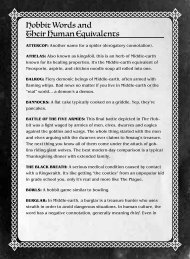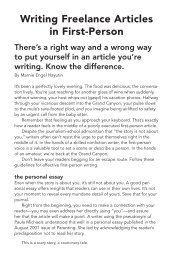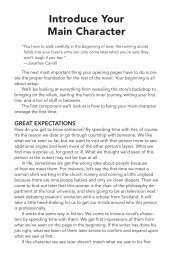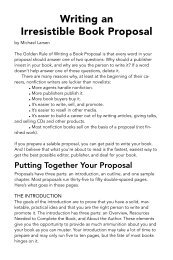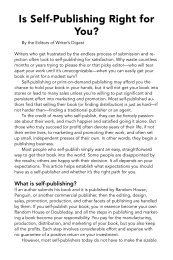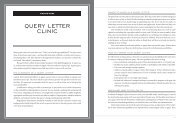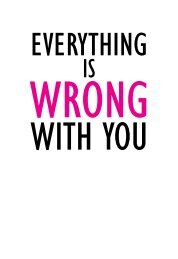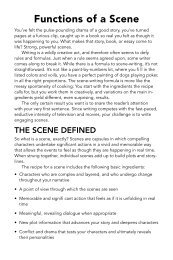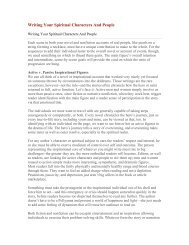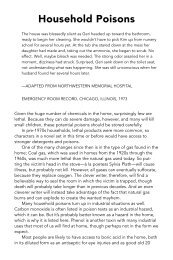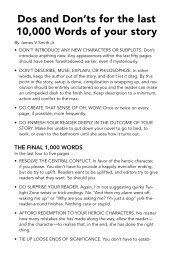ARTICLE QUERY FAQS - Writer's Digest
ARTICLE QUERY FAQS - Writer's Digest
ARTICLE QUERY FAQS - Writer's Digest
You also want an ePaper? Increase the reach of your titles
YUMPU automatically turns print PDFs into web optimized ePapers that Google loves.
<strong>ARTICLE</strong> <strong>QUERY</strong> <strong>FAQS</strong><br />
Still have questions? You should. It’s impossible to cover every aspect of writing in one<br />
book, let alone one chapter. (But don’t blame us for trying!) Here are some frequently<br />
asked questions when it comes to article queries.<br />
1. WHAT IS THE BEST WAY TO SUBMIT A PHOTO?<br />
WHAT ELSE DO I NEED TO INCLUDE?<br />
Many writer’s guidelines will state how the editor prefers to receive photo submissions.<br />
The guidelines might just ask that you simply indicate in your query that<br />
photos are available upon request, or they might go so far as to list a method<br />
for sending them (by e-mail as an attachment or via snail mail). If you can’t find<br />
this information in the writer’s guidelines, simply indicate that you can provide
photos upon request—if the subject matter is obvious. A profile on author Julia<br />
Cameron will most likely include her photo (and perhaps some jacket covers of<br />
her books), while an article on preparing for a marathon leaves room for interpretation.<br />
In the latter case, you’ll need to indicate if you’ll be supplying photos<br />
of rain gear, running shoes, someone training for a marathon, or a crowd of people<br />
actually running a marathon.<br />
You’ll always need to include a photo caption (even if the editor chooses<br />
to rewrite it) and, in the case of a nonpublic photo of a person or people, you’ll<br />
need to include a model release. (You can easily find one on the Web by doing<br />
a Google search.) If the photo is supplied (that is, taken by someone other than<br />
yourself), indicate if you need to print a photo credit and to whom the photo<br />
should be credited.<br />
Photos can be submitted in many different formats: JPGs, TIFFs, slides, transparencies,<br />
and prints. Some magazines only use color or only black and white, so<br />
find out in advance what the publication’s needs are.<br />
For those not already familiar with the acronym dpi (dots per inch), it refers<br />
to the measurement density of resolution. Most publications will require that<br />
your photos be “high-resolution,” that is, at least 300 dpi. A lower resolution<br />
will look fuzzy when printed—even if it looks good on your computer screen—so<br />
make sure your camera is set to take high-resolution pictures or that the person<br />
providing you with photos understands what you need. (Most Web-only publications<br />
will accept 72 dpi.)<br />
2. SHOULD I INCLUDE CLIPS—EVEN IF THEY’RE ON TOPICS THAT MIGHT<br />
OFFEND THE EDITOR?<br />
If your only clips are irrelevant to the topic you’re pitching but do show your writing<br />
style, I’d say include them. If, however, you’re pitching Christianity Today and<br />
your only published pieces were with Playboy, you’ll need to find a way around<br />
that. Here are a few options:<br />
• If the pieces you wrote for Playboy were clean (such as an in-depth feature on<br />
why divorce is still on the rise and a how-to piece on personal grooming) but you<br />
don’t want the editor to know where they ran, include the articles as clips by<br />
printing them off (or e-mailing the Microsoft Word documents) from your own<br />
computer (as opposed to sending the tear sheets that have Playboy printed on
the bottom of the pages). Then, just indicate in your query that you’ve included<br />
published clips—but don’t indicate where they ran. (Heck, if you’re good enough<br />
to get published in Playboy, you probably won’t have a hard time demonstrating<br />
your skills!)<br />
• Use a more general approach, ending your query with a paragraph about how<br />
you’re “a full-time freelance writer whose work has appeared in local and national<br />
publications.”<br />
• Use a more general approach, citing the types of material you’ve had published<br />
with something like, “I’m a freelance writer whose published pieces range from<br />
short how-to pieces on personal grooming to in-depth reporting on the decline<br />
of marriage.”<br />
Remember the old adage: “When in doubt, leave it out.”<br />
3. WHAT ARE THE BEST MARKETS TO BREAK INTO?<br />
That depends on a lot of factors, including who you are, what you write (essays,<br />
articles, tips, short stories), what you write about, what you read, and where you<br />
live. Assuming all things equal (i.e., no writing clips):<br />
• Who you are: If you’re an African American mother of three, for example, you’ll<br />
have an advantage to query for a publication like Black Woman and Child magazine.<br />
Likewise, a former jewelry store owner is going to have a better shot than<br />
most at breaking into Modern Jeweler.<br />
• What you write: Are you big into personal essays? Look for the national consumer<br />
magazines (Woman’s Day, Family Circle, The Sun) that designate a specific<br />
page (or section) for personal essays. These are often sent in by “regular people”<br />
(nonfreelancers) but are paid. Short fillers like news briefs and tips are also a<br />
great way to crack a big market if you don’t have writing credentials. Big magazines<br />
like ePregnancy and Men’s Health often uses upwards of one hundred per<br />
issue, so there’s always a market.<br />
• What you write about: Obviously, there are a lot more markets for health writers<br />
than those who write about helicopter safety or teaching theatre. But that’s<br />
not to say you’ll have a hard time getting published if you’re the latter. In fact,<br />
you may have an easier time breaking in because there’s so much less competition<br />
and always a need for new ideas in niche markets.
• What you read: Who better to keep tabs on what stories have run—and<br />
what still needs to be covered—in a magazine than its die-hard fans? Subscribers<br />
or long-time readers of a publication should indicate so in their query.<br />
Editors like to hear from their readers, and readers who can fill the gaps<br />
on missed coverage by suggesting articles—especially if they can write them—<br />
are always welcome.<br />
• Where you live: The good news about living in a huge metropolitan area is that<br />
there are always plenty of publications to query. The bad news is, there are often<br />
plenty of local wannabe writers doing the same. The reverse can be said about<br />
small towns: fewer publications to pitch, but fewer writers to compete with. Of<br />
course, the Internet allows, to a certain extent, for all writers to be equal in terms<br />
of proximity to a publication, but it’s a lot harder to break into Atlanta Parent if<br />
you live in Denver because the editor will know you’re not reading the publication<br />
regularly.<br />
If you’re just starting off, query a local or regional magazine and let them know<br />
you’ll be including quotes from the locals, photos from the area, or local events.<br />
Those are big promises to live up to for your out-of-state competition.<br />
4. HAVE YOU EVER HAD SUCCESS PITCHING MORE THAN ONE IDEA<br />
IN A <strong>QUERY</strong>?<br />
I have, but it’s not something I recommend for new writers. I have a multiarticle<br />
query that I frequently send to start-up parenting magazines that are on a limited<br />
budget. Because the articles have all been previously published, any money I<br />
receive for them is essentially gravy.<br />
I mention that the articles are reprints and that they’re available for a set<br />
amount of, say, thirty dollars each (plus a contributor’s copy for my portfolio), and<br />
most of the publications I approach end up buying at least one, if not more.<br />
You do have to be cautious with this approach, keeping careful track of where<br />
you submit (so you don’t hit up two parenting publications in Dallas, for example)<br />
and that you’re not infringing on any contract agreements. If you sell an article to<br />
Miami Parent with a contract clause that says “author will not resell the article to<br />
any other publications in the state of Florida for one year,” you’ll need to wait a<br />
full year from publication before approaching any Florida publications.<br />
See Example 2.3 (pg. 67) for this type of query.
5. HOW CAN I SELL AN <strong>ARTICLE</strong> MORE THAN ONCE?<br />
Of all the things you’ll learn about freelancing, this might be the trickiest.<br />
When you create a piece (article, essay, poem, short story, etc.), you automatically<br />
hold all the rights to said piece. When you agree to allow a publisher<br />
use your work—in print, on the Web, or both—you are granting the publisher<br />
certain temporary or permanent rights. In general, the more rights you sell, the<br />
less potential you have to continue making money off your piece. Therefore, aim<br />
to keep as many rights as possible, whenever possible. Sometimes, you’ll be able<br />
to negotiate with a publisher on what rights you’re willing to sell. Other times,<br />
as with large-circulation consumer magazines or online publications, there’s no<br />
room for haggling.<br />
Here are the rights you’ll encounter most when selling an article:<br />
• One-time rights: A favorite among writers, one-time rights (aka simultaneous<br />
rights) allow you to license rights to more than one publication at a time (unless<br />
there is a specific clause indicating that you won’t sell the piece to other publications<br />
in that city, region, or state for a set period of time). The term one-time<br />
means that the publication can only print it once—unless they specifically ask<br />
your permission to run it again in a future issue.<br />
• First serial rights: Another good one. These rights allow a publication to be the<br />
first to use your piece. Once published, all rights revert back to you. You cannot<br />
sell first serial rights to more than one publication (only one can be the first<br />
to use it) unless there is a regional qualifier, such as “first North American serial<br />
rights.” In that case, you could sell first rights to a magazine in North America<br />
and, say, Europe, at the same time (unless the publication in Europe asked for all<br />
rights, first world rights, or first English-language rights).<br />
• Second serial rights: Also known as reprint rights, this is where you make<br />
your icing on the cake. Although most publications pay quite a bit less money<br />
to license reprint rights, you’ve probably already made money by selling first<br />
rights, making any income from reprint rights feel like “extra” income for virtually<br />
no work. (Sure, you had to query the publication, but you didn’t have to<br />
write a new article or revise it.)<br />
• All rights: Ugh. Selling all rights means you are signing away any rights to ever<br />
use the piece again. If you sold all rights to a poem, for example, you couldn’t
EXAMPLE 2.3<br />
GOOD MULTI<strong>ARTICLE</strong> <strong>QUERY</strong><br />
January 1, 2008<br />
Don Daniels<br />
Kennedy Parents Magazine<br />
123 Maine St.<br />
Kennedy, MA 12345<br />
Dear Mr. Daniels,<br />
I’m not sure if you were at the national Parenting Publications of America conference in<br />
March, but I had a flyer listing the following reprints. Each is available for just thirty dollars:<br />
1. “ Getting Your Kids to EAT YOUR VEGGIES!” (485 words)<br />
2. “ My Kids Are Driving Me Crazy! Ten Tips for Staying Calm When Your Kids<br />
Aren’t” (1,132 words)<br />
3. “ Music to Your Ears: Is Your Child Ready for Music Lessons?” (845 words)<br />
4. “ What’s the Number for 911? The Essential Assume-Nothing List for Your<br />
Babysitter” (845 words)--Good for dotted-line cut-out for refrigerator<br />
5. “ It’s Your Move, Kid! Helping Your Child Prepare for the Family Move” (638 words)<br />
6. “ The First Day of School: Helpful Hints and Money-Saving Tips” (560 words)<br />
7. “ Dealing with Dr. Phobia: When Your Child Is Afraid of the Doctor” (749 words)<br />
8. “ Raising Polite Children in Impolite Times” (975 words)<br />
9. “ The Season of Superwoman: Surviving a Kryptonite Christmas” (1,097 words)<br />
10. “ Growing Up Online: A Parent’s Guide to Reinventing the Lost Art of Play”<br />
(1,000 words)<br />
11. “ Twenty-five Tips for a Safe Holiday Season” (short and long versions available)<br />
12. “ Birthday Brilliance” (869 words + sidebar)<br />
CREDENTIALS<br />
• More than 500 published pieces, including articles in Family Circle, The New York<br />
Times, Woman’s World, ePregnancy, Nashville Parent, Vermont Parent and Child,<br />
The Parent Planner, Complete Woman, Christian Parenting Today, Woman’s Own,<br />
American Fitness, and on the Nemours Foundation’s KidsHealth.org<br />
• Former editor, columnist, staff writer, and regular contributor (now full-time<br />
freelancer)<br />
• Author of two women’s nonfiction humor books for McGraw-Hill: Oh, Solo<br />
Mia! The Hip Chick’s Guide to Fun for One and Work It, Girl! 101 Tips for the<br />
Hip Working Chick
I’d be happy to send any or all of the articles for your review. Thank you for your time.<br />
Best regards,<br />
Wendy Burt-Thomas<br />
(address, phone, e-mail)<br />
even use it in your own self-published book of poetry unless you asked for—and<br />
were granted—permission by the publisher.<br />
Why would a writer ever sell all rights? Inexperience, desperation, money, or<br />
prestige. At least the latter two can help you. After all, it’s hard to pass up the<br />
opportunity to have Time magazine on your résumé, and even harder to pass up<br />
three thousand dollars when your rent is due.<br />
• Electronic rights. Sometimes referred to as e-rights, these cover a variety<br />
of electronic media, including online publications (like www.nytimes.com or<br />
www.salon.com), blogs, public and private Web sites, e-zines, and streaming<br />
media. A good contract will specify exactly what type(s) of electronic rights are<br />
being purchased. If a magazine editor doesn’t seem to know what rights he’s<br />
asking to license, take the reins and offer one-time print rights (or in the case<br />
of online publications, aim for a specified time frame, such as one year of archival,<br />
in order to have your article offline for good).<br />
You’ll find that many small publications don’t even bother with contracts.<br />
That’s because The Copyright Law of 1978 states that unless the publisher and<br />
author agree on licensing rights in writing, it’s assumed that the publication is<br />
only purchasing one-time rights. Just be forewarned: I’ve received checks and<br />
contributors’ copies in the mail with no previous indication that the publications<br />
had chosen to accept the articles I had sent them. While it’s nice to receive unexpected<br />
checks, you don’t want to have sold infringing rights to another publication<br />
in the meantime.<br />
6. HOW DO I PROTECT MY IDEAS?<br />
You can’t. Ideas can’t be copyrighted, only pieces of work. New writers often complain<br />
that they pitched an idea that was rejected only to later see it in the maga-
zine. Chances are, the publication was planning to run the article before the writer<br />
queried, and that’s why the idea was rejected—not the other way around.<br />
And while some publication may have “lifted” your idea to give to a more qualified<br />
writer, it’s rare. Some do offer “idea fees” to writers, though again, that’s rare.<br />
As for publications stealing your actual writing, the odds are next to nothing.<br />
No reputable publisher wants to worry about an expensive lawsuit, not to<br />
mention the bad publicity that comes with such a fiasco. If you’re really worried<br />
about it, feel free to register your work with the United States Copyright Office<br />
(www.copyright.gov). A basic online filing is only thirty-five dollars.<br />
7. HOW MANY QUERIES CAN I SEND AT ONCE TO ONE PUBLICATION?<br />
TO MORE THAN ONE?<br />
It’s not recommended that you send a publication more than one query at a time.<br />
Wait to hear back from the editor regarding the first idea. If it’s rejected, feel<br />
free to send her another query, taking into account why she rejected the first<br />
idea (if indicated in the editor’s response). If the first idea is accepted, wait until<br />
your article is published before sending her another query.<br />
There is no limit on the number of simultaneous submissions (or queries) you<br />
can send to multiple publications. Just be forewarned that if you get multiple acceptances,<br />
you’ll have to be very cautious about what rights you can offer. If one<br />
magazine offers you one hundred dollars for first North American serial rights<br />
and you accept, what will you do if a second publication offers you five hundred<br />
dollars the very next day? While it’s possible to withdraw your agreement with<br />
the first publication (if you haven’t signed a contract yet), you’ll most likely be<br />
burning a bridge with that editor. Remember, sometimes money isn’t the only<br />
thing to consider. A long-term relationship with an editor can take your career a<br />
long way.<br />
8. HOW DO I ESTIMATE WORD COUNT?<br />
While I’d argue that with today’s computer technology there’s really no excuse<br />
for lacking an exact word count, there is a simple way to estimate your article’s<br />
length. Assuming a one-inch margin, double spacing, and a 12-point font (like<br />
Times New Roman), multiply your pages by 250 words. A ten-page feature, then,<br />
would be 2,500 words.
9. CAN I SEND A <strong>QUERY</strong> FOR AN <strong>ARTICLE</strong> BEFORE I’VE LINED UP<br />
MY INTERVIEWS?<br />
Yes, although you should be cautious about mentioning specific names if you<br />
haven’t yet confirmed that the person is willing to speak with you. In your query<br />
you could mention that you’ll be interviewing “a pediatrician, a single mom, and<br />
a teacher” (rather than specific names) to allow you to find replacements if your<br />
first picks don’t come through.<br />
If the person you’re interviewing is famous or prominent, you should have<br />
permission to speak with him (or e-mail him questions) before you query. This<br />
will serve two purposes: It will protect you from having to scrap the story (and<br />
tick off your editor) if the interviewee declines the opportunity, and it will likely<br />
increase your chances of landing the assignment in the first place. After all, what<br />
editors would turn down the opportunity to scoop their competition with a celebrity<br />
interview for which you’ve already received the go-ahead from his publicist?<br />
Just be very clear in your query that the interview is already approved.<br />
10. HOW DO I GET INTERVIEWS?<br />
While getting an interview with a celebrity will likely require you to contact her<br />
publicist or agent, interviewing a noncelebrity will probably require little more<br />
than a nice e-mail or phone call. Most “regular” people are delighted to be a resource<br />
and see their name in print. Even better—they don’t expect to be compensated<br />
for their quotes or information, although many will ask for at least one<br />
copy of the publication to show friends and family.<br />
The key to contacting a noncelebrity for an interview is to keep your letter<br />
simple. You don’t need to go into detail about the piece, the publication, or that<br />
you’ve never had anything published. What you might want to include is why<br />
you chose him, that you’re still in the query stage (if you are), and that you’re<br />
flexible in terms of how and when to interview him. Here’s a short example:<br />
Dear Mr. Philips,<br />
I am a freelance writer working on a story about successful family-owned<br />
franchises that I will be pitching to numerous local and national magazines. A<br />
friend recently told me about your company making Entrepreneur’s Top 500<br />
franchises and I would love to ask you a few questions about your business.



